NASA completes alignment of JWST mirrorsby Jeff Foust — March 16, 2022 [SN]
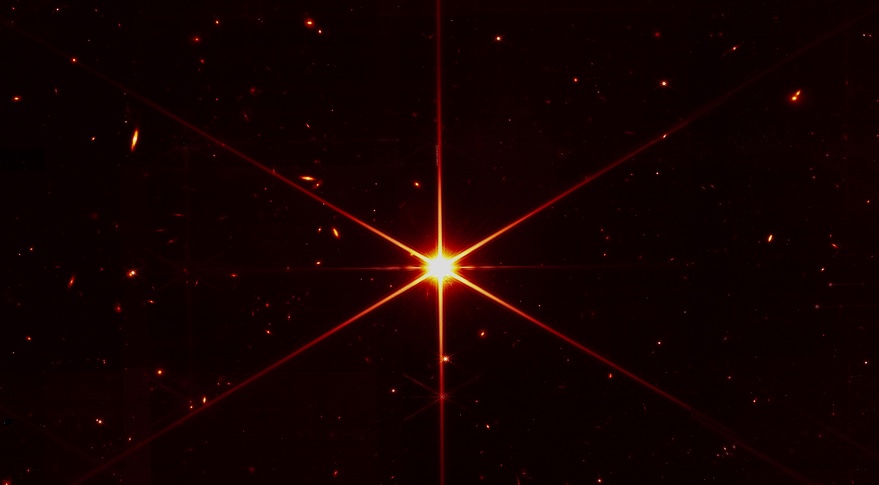 An image of the star 2MASS J17554042+6551277 taken by the James Webb Space Telescope that confirmed the performance of the spacecraft's optics. The rays are diffraction patterns from the shape of the mirror segments. Credit: NASA/STScI
An image of the star 2MASS J17554042+6551277 taken by the James Webb Space Telescope that confirmed the performance of the spacecraft's optics. The rays are diffraction patterns from the shape of the mirror segments. Credit: NASA/STScIWASHINGTON — NASA has completed the next step in the commissioning of the James Webb Space Telescope by fine-tuning the alignment of its primary mirror segments, confirming the telescope’s optics will meet or exceed expectations.
Source:
https://spacenews.com/nasa-completes-alignment-of-jwst-mirrors/JWST entering “home stretch” of commissioningby Jeff Foust — May 9, 2022 [SN]
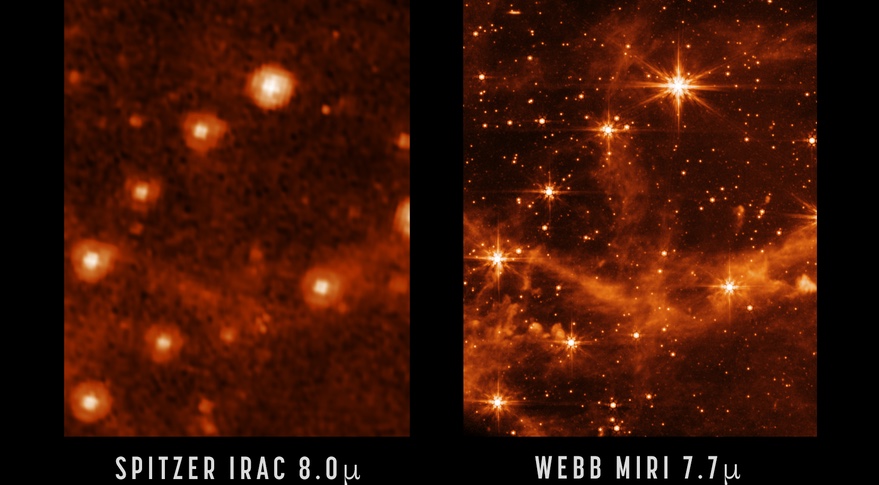 NASA released May 9 a comparison of an image taken by the Spitzer Space Telescope with one at a similar wavelength by JWST, illustrating the latter's better performance: Credit: NASA/JPL-Caltech (left), NASA/ESA/CSA/STScI (right)
NASA released May 9 a comparison of an image taken by the Spitzer Space Telescope with one at a similar wavelength by JWST, illustrating the latter's better performance: Credit: NASA/JPL-Caltech (left), NASA/ESA/CSA/STScI (right)WASHINGTON — The James Webb Space Telescope is operating better than expected as the spacecraft enter the final stages of commissioning, project officials said May 9.
In a call with reporters, scientists and mission managers said they have completed the alignment of the telescope’s optics with all its instruments and now are moving into setting up the instruments for science operations, the final step in a commissioning process that started shortly after the telescope’s launch on Christmas Day last year.
https://spacenews.com/jwst-entering-home-stretch-of-commissioning/NASA assesses micrometeoroid impact on James Webb mirror segmentJune 8, 2022 William Harwood STORY WRITTEN FOR CBS NEWS & USED WITH PERMISSION [SN]
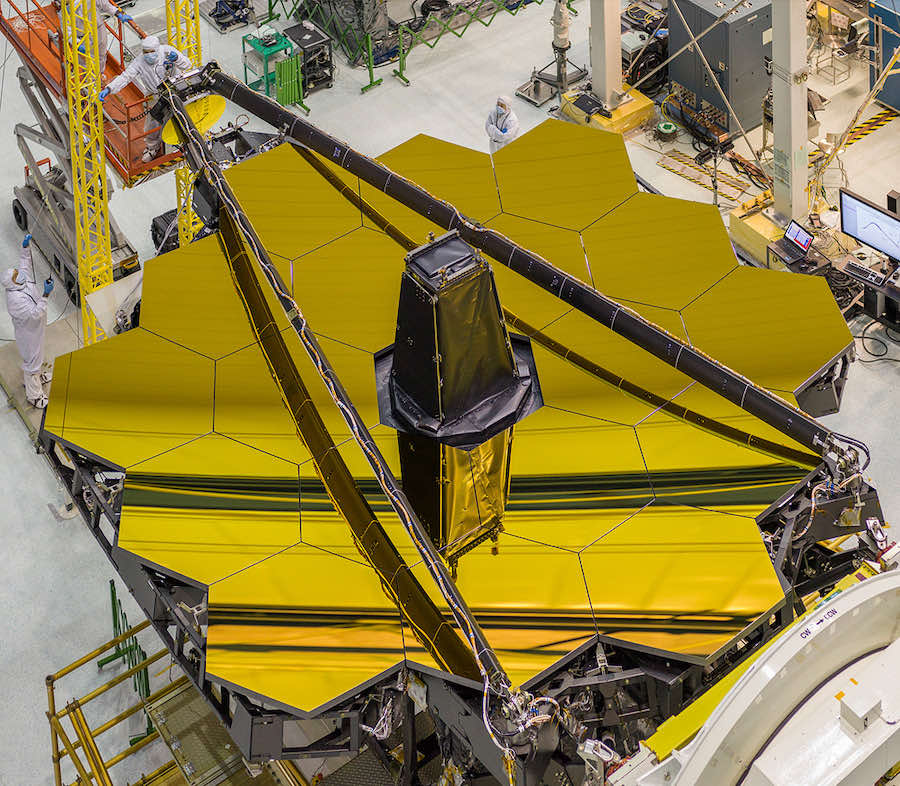 Webb’s primary mirror is made up of 18 hexagonal gold-coated beryllium segments that must be aligned to within a tiny fraction of the width of a human hair to achieve a sharp focus. This photo shows the mirror during pre-launch preparations with the telescope’s secondary mirror folded away for flight. Credit: NASA
Webb’s primary mirror is made up of 18 hexagonal gold-coated beryllium segments that must be aligned to within a tiny fraction of the width of a human hair to achieve a sharp focus. This photo shows the mirror during pre-launch preparations with the telescope’s secondary mirror folded away for flight. Credit: NASAA high-speed dust-size micrometeoroid slammed into one of the James Webb Space Telescope’s 18 primary mirror segments last month, causing a slight but noticeable effect on the segment’s performance, NASA said Wednesday. It was the fifth such impact detected since Webb’s Christmas Day launch.
Given the $10 billion telescope’s open design, with its mirrors exposed to space, engineers expected random hits by bits of space dust over the life of the observatory, but an impact between May 23 and 25 was larger than pre-flight models predicted.
https://spaceflightnow.com/2022/06/08/nasa-assesses-micrometeoroid-impact-on-james-webb-mirror-segment/NASA prepares to release first JWST science imagesby Jeff Foust — June 29, 2022 [SN]
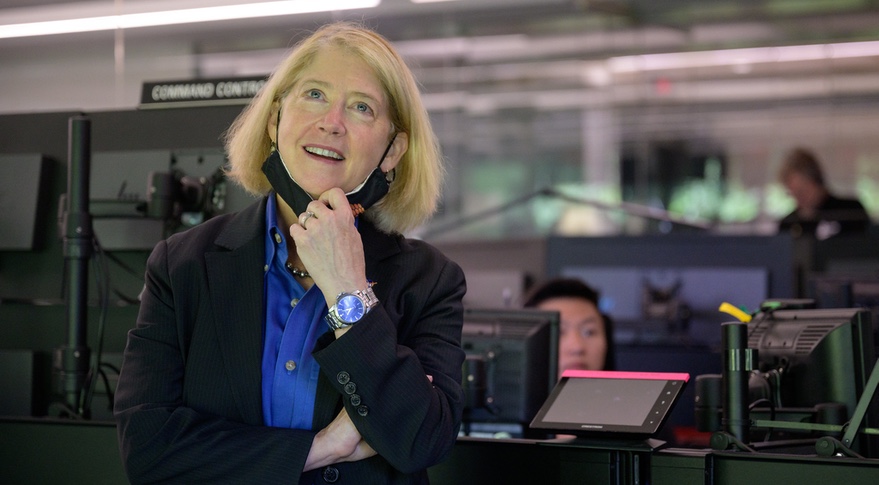 NASA Deputy Administrator Pam Melroy views raw images from the James Webb Space Telescope while visiting the Space Telescope Science Institute June 29. Credit: NASA/Bill Ingalls
NASA Deputy Administrator Pam Melroy views raw images from the James Webb Space Telescope while visiting the Space Telescope Science Institute June 29. Credit: NASA/Bill IngallsBALTIMORE — With commissioning of the James Webb Space Telescope nearly complete, project officials and NASA leadership promise the telescope’s first images will stun scientists and the public alike.
During a media event at the Space Telescope Science Institute (STScI) here June 29, project managers and scientists said the telescope is already collecting “early release observations” that NASA, along with the European Space Agency and Canadian Space Agency, will unveil July 12. Those observations are taking place as engineers finish preparing the telescope for routine science observations, with 15 of its 17 observing modes now commissioned.
https://spacenews.com/nasa-prepares-to-release-first-jwst-science-images/Astronomers eagerly await first images from the James Webb Space TelescopeJuly 10, 2022 William Harwood STORY WRITTEN FOR CBS NEWS & USED WITH PERMISSION [SFN]
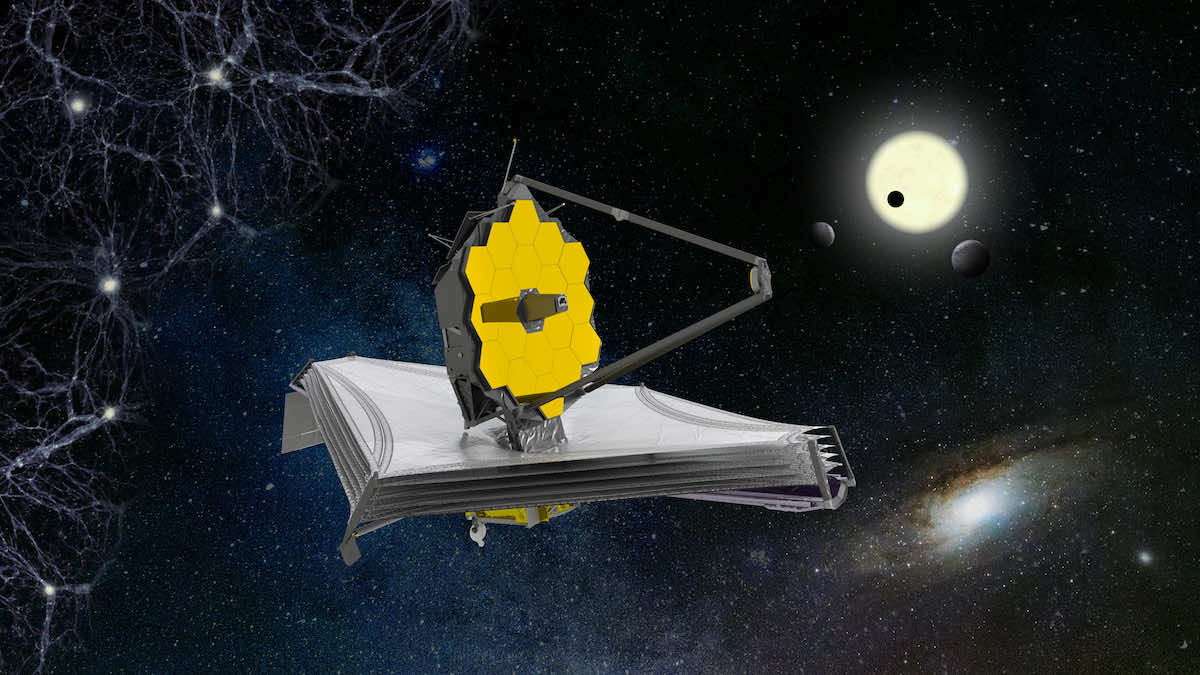 Artist’s concept of the James Webb Space Telescope as it appears in space. Credit: ESA/ATG medialab
Artist’s concept of the James Webb Space Telescope as it appears in space. Credit: ESA/ATG medialabAfter six months of tests and checkout, NASA’s James Webb Space Telescope is finally ready to open a new window on the universe, capturing the faint light of the first stars and galaxies, probing the mysteries of black holes and studying the atmospheres of alien worlds.
On Tuesday, NASA will unveil the first color images from the $10 billion observatory, photos expected to rival or surpass the first spectacular images from the repaired Hubble Space Telescope nearly three decades ago.
https://spaceflightnow.com/2022/07/10/astronomers-eagerly-await-first-images-from-the-james-webb-space-telescope/NASA releases first color image from James Webb Space Telescopeby Jeff Foust — July 11, 2022 [SN]
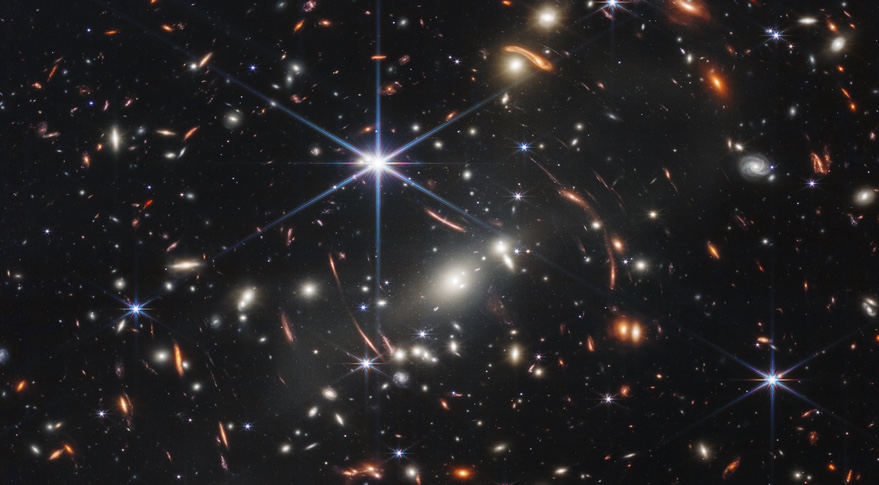 The first color image released from JWST shows a galaxy cluster called SMACS 0723, whose gravity acts like a lens revealing more distant galaxies. Credit: NASA, ESA, CSA, and STScI
The first color image released from JWST shows a galaxy cluster called SMACS 0723, whose gravity acts like a lens revealing more distant galaxies. Credit: NASA, ESA, CSA, and STScIWASHINGTON — A deep field of distant galaxies, some dating back to the first billion years after the Big Bang, is the first full-color image to come from the James Webb Space Telescope.
The image, released at a White House event July 11 and called “Webb’s First Deep Field,” is a sneak preview of a broader set of early release observations that NASA and its European and Canadian partners on JWST plan to publish July 12. The White House event, attended by President Joe Biden and Vice President Kamala Harris, was announced with less than 24 hours’ notice.
The image shows a galaxy cluster called SMACS 0723 about 4.5 billion light-years away. The cluster acts as a gravitational lens, bringing into view far more distant galaxies, some of which appear in the image as arcs.
“We’re looking back more than 13 billion years,” said NASA Administrator Bill Nelson at the event. The NASA statement accompanying the image release didn’t give specifics on the more distant galaxies visible in the image, which involved 12.5 hours of images taken at several wavelengths. The Big Bang took place an estimated 13.8 billion years ago, meaning those distant galaxies date back to when the universe was less than a billion years old.
https://spacenews.com/nasa-releases-first-color-image-from-james-webb-space-telescope/Webb telescope peers deeper into the universe than ever beforeJuly 11, 2022 Stephen Clark [SFN]
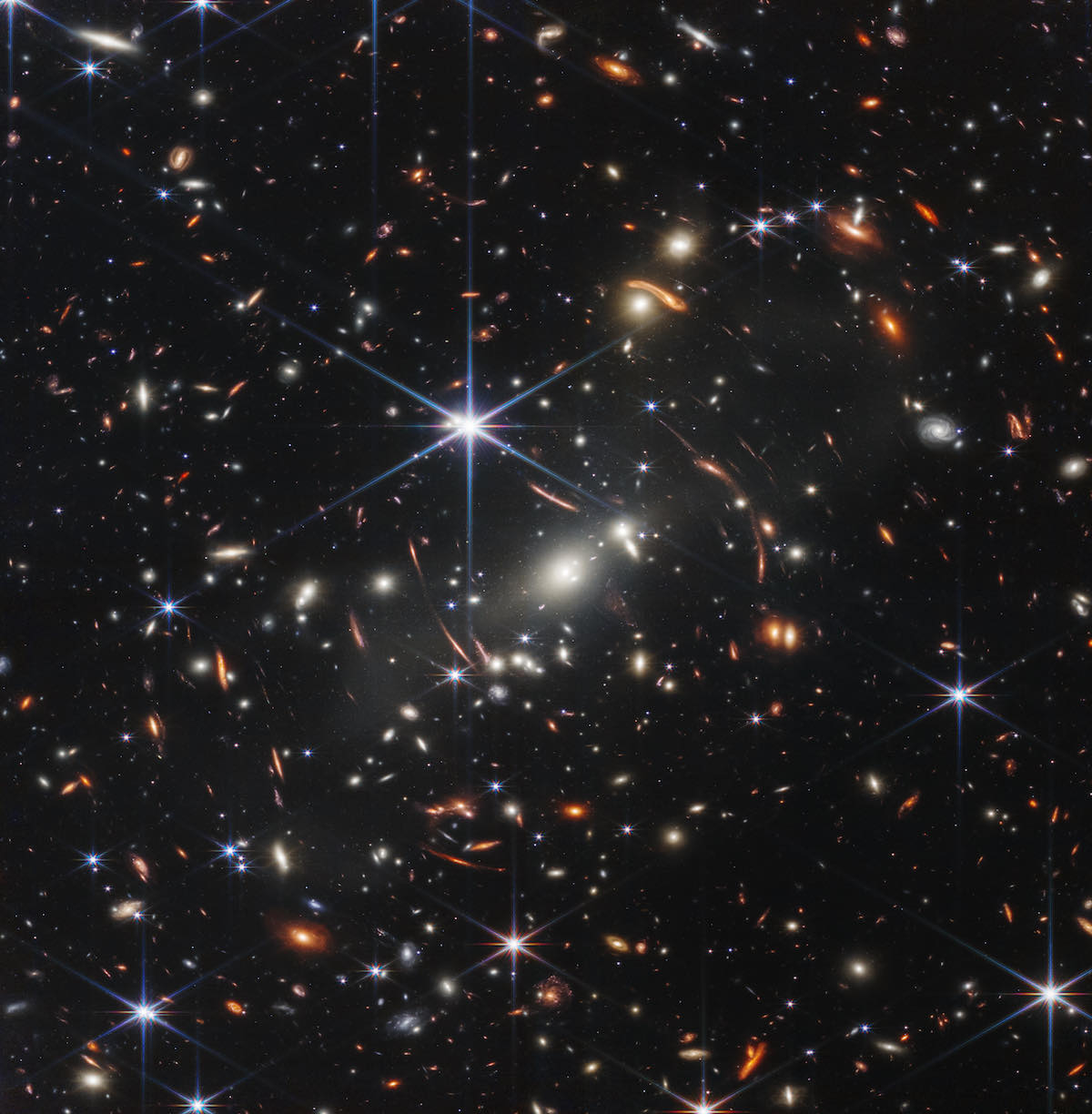 This is the first science image released to the public from the James Webb Space Telescope, showing thousands of galaxies in the deepest ever look into the distant universe. Webb’s NIRCam instrument captured this view in different wavelengths with exposures totaling 12.5 hours. Credit: NASA, ESA, CSA, STScI
This is the first science image released to the public from the James Webb Space Telescope, showing thousands of galaxies in the deepest ever look into the distant universe. Webb’s NIRCam instrument captured this view in different wavelengths with exposures totaling 12.5 hours. Credit: NASA, ESA, CSA, STScIPresident Biden unveiled the deepest ever look into the distant universe Monday with the release of the first full-color science image from the James Webb Space Telescope, showing thousands of faint galaxies and countless stars shining like lampposts in a tiny patch of the southern sky.
https://spaceflightnow.com/2022/07/11/webb-first-image/First JWST images excite and relieve astronomersby Jeff Foust — July 12, 2022 [SN]
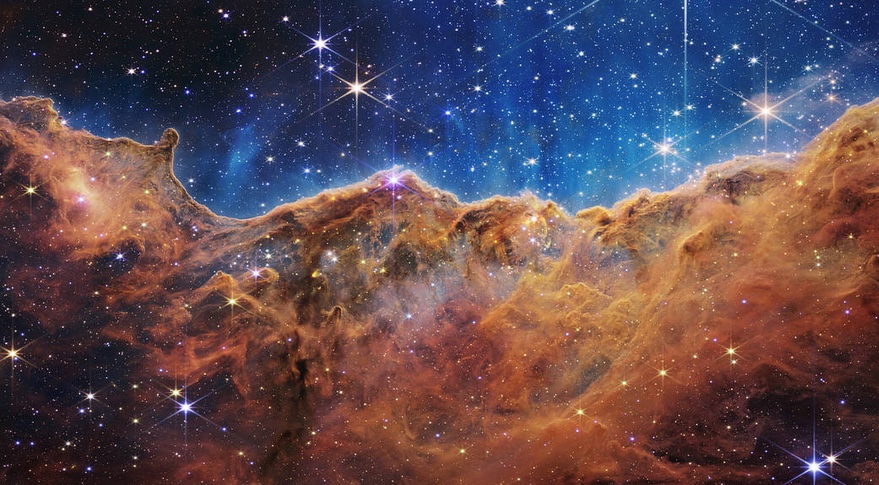 A region of the Carina Nebula observed by the James Webb Space Telescope, part of a set of images and spectra released July 12 to show off the capabilities of the telescope. Credit: NASA, ESA, CSA, and STScI
A region of the Carina Nebula observed by the James Webb Space Telescope, part of a set of images and spectra released July 12 to show off the capabilities of the telescope. Credit: NASA, ESA, CSA, and STScIGREENBELT, Md. — NASA released the long-anticipated first science observations from the James Webb Space Telescope July 12, the culmination of decades of work and the start of a new era in astrophysics.
The observations, released during an event at NASA’s Goddard Space Flight Center here a day after the unveiling of one image at a White House event, illustrated the capabilities of the $10 billion space telescope from analyzing the atmospheres of exoplanets to detecting hundreds of galaxies in the early universe.
https://spacenews.com/first-jwst-images-excite-and-relieve-astronomers/NASA sees JWST success helping win agency support and fundingby Jeff Foust — July 13, 2022 [SN]
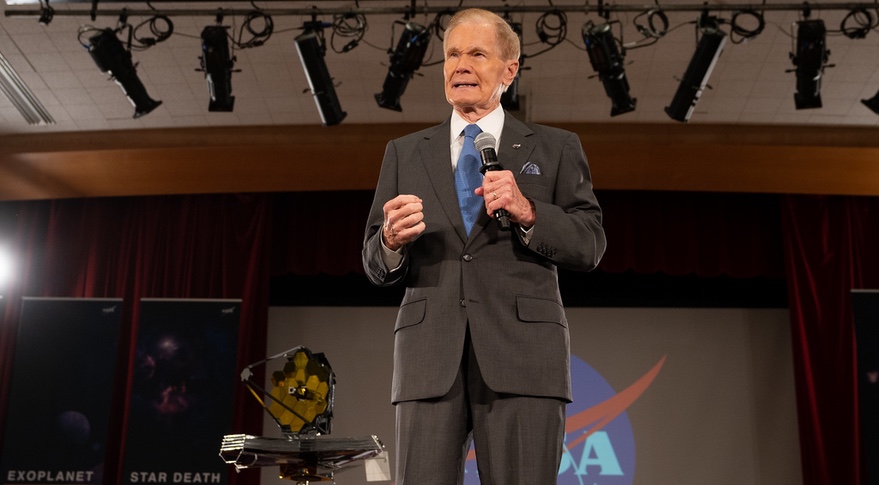 Bill Nelson told attendees of a JWST event at the Goddard Space Flight Center July 12 that President Biden and Vice President Harris “asked just a million questions” about JWST’s first images at a White House briefing the day before. Credit: NASA/Taylor Mickal
Bill Nelson told attendees of a JWST event at the Goddard Space Flight Center July 12 that President Biden and Vice President Harris “asked just a million questions” about JWST’s first images at a White House briefing the day before. Credit: NASA/Taylor MickalGREENBELT, Md. — The James Webb Space Telescope, once an albatross around the neck of NASA, has become a symbol of the agency’s capabilities and potentially a tool to win support and funding for other programs.
That transformation has become evident with the successful launch and commissioning of the $10 billion space telescope, culminating with the release of initial observations by JWST July 12. The first image, a “deep field” view that captured galaxies from the early universe, was unveiled at a White House event a day earlier.
https://spacenews.com/nasa-sees-jwst-success-helping-win-agency-support-and-funding/Webb views the ‘cosmic cliffs’ of Carina NebulaJuly 12, 2022 Stephen Clark [SFN]
 Carina Nebula viewed by the James Webb Space Telescope. Credit: NASA, ESA, CSA, and STScI
Carina Nebula viewed by the James Webb Space Telescope. Credit: NASA, ESA, CSA, and STScIThe James Webb Space Telescope’s first image of Carina Nebula shows an iconic star-forming cloud of gas and dust 7,600 light-years away, revealing previously unseen vistas of young stars thanks to the new observatory’s sharp-eyed infrared vision.
This is one of the first batch of images from Webb revealed Tuesday by the science team working on the $10 billion mission.
https://spaceflightnow.com/2022/07/12/webb-views-the-cosmic-cliffs-of-carina-nebula/Stephan’s Quintet: Five galaxies imaged by James Webb Space TelescopeJuly 12, 2022 Stephen Clark [SFN]
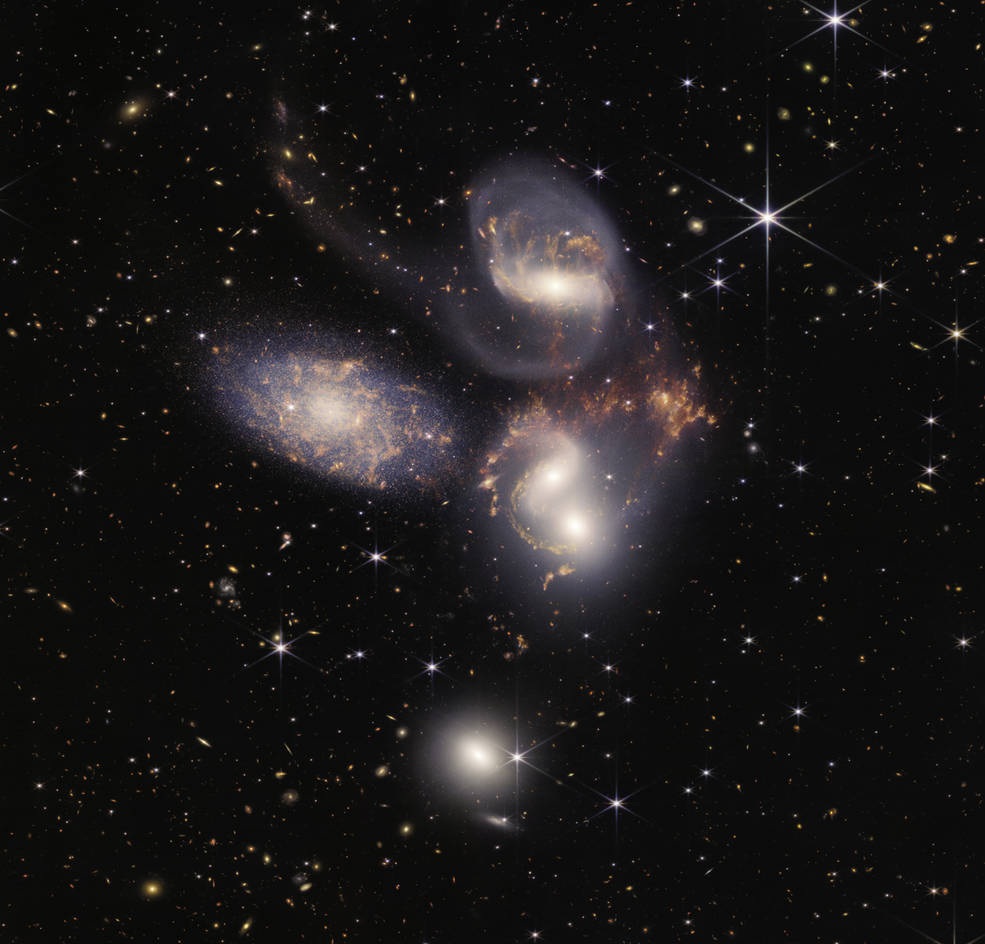 Stephen’s Quintet viewed by the James Webb Space Telescope. The leftmost galaxy, named NGC 7320, is located 40 million light-years from Earth. The other four galaxies (NGC 7317, NGC 7318A, NGC 7318B, and NGC 7319) are closer together and are located about 290 million light-years away. Credit: NASA, ESA, CSA, STScI
Stephen’s Quintet viewed by the James Webb Space Telescope. The leftmost galaxy, named NGC 7320, is located 40 million light-years from Earth. The other four galaxies (NGC 7317, NGC 7318A, NGC 7318B, and NGC 7319) are closer together and are located about 290 million light-years away. Credit: NASA, ESA, CSA, STScIThe five galaxies of Stephan’s Quintet, prominently featured at the beginning of the holiday film “It’s a Wonderful Life,” were seen with new eyes by the James Webb Space Telescope.
Located in the northern constellation Pegasus, Stephan’s Quintet consists of four galaxies that are tightly bound — cosmically speaking — about 290 million light-years away. In a coincidence of cosmic alignment, a foreground galaxy lurks on the left of the image about 40 million light-years from Earth.
https://spaceflightnow.com/2022/07/12/stephans-quintet-five-galaxies-imaged-by-james-webb-space-telescope/A dying star through the eyes of the James Webb Space TelescopeJuly 12, 2022 Stephen Clark [SFN]
 This side-by-side comparison shows observations of the Southern Ring Nebula in near-infrared light, at left, and mid-infrared light, at right, from NASA’s Webb Telescope. Credit: NASA, ESA, CSA, STScI
This side-by-side comparison shows observations of the Southern Ring Nebula in near-infrared light, at left, and mid-infrared light, at right, from NASA’s Webb Telescope. Credit: NASA, ESA, CSA, STScIThe James Webb Space Telescope’s multi-wavelength observations of the Southern Ring Nebula reveal the dying throes of a star flinging off vast amounts of stellar debris, and showed for the first time the star responsible for the spectacle is sheathed in its own cloak of dust.
https://spaceflightnow.com/2022/07/12/a-dying-star-through-the-eyes-of-the-james-webb-space-telescope/JWST teases new era in exoplanet astronomyJuly 12, 2022 Stephen Clark [SFN]
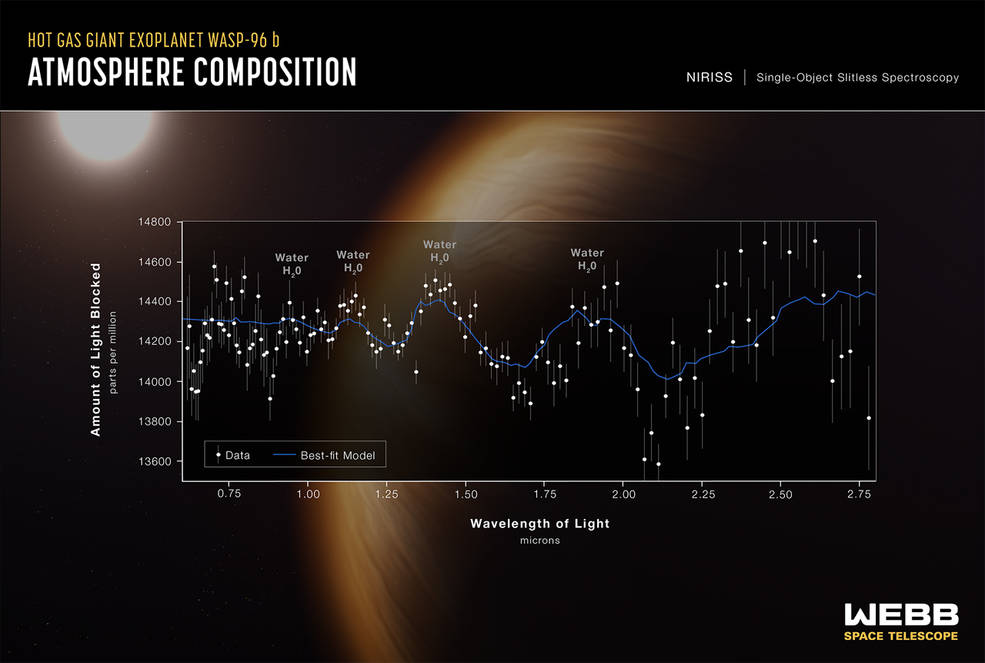 NASA’s James Webb Space Telescope has captured the distinct signature of water, along with evidence for clouds and haze, in the atmosphere surrounding a hot, puffy gas giant planet orbiting a distant sun-like star. Credit: NASA, ESA, CSA, STScI
NASA’s James Webb Space Telescope has captured the distinct signature of water, along with evidence for clouds and haze, in the atmosphere surrounding a hot, puffy gas giant planet orbiting a distant sun-like star. Credit: NASA, ESA, CSA, STScIAmong the dazzling images from the James Webb Space Telescope released Tuesday was a squiggly line of spectral data that contained the tell-tale chemical fingerprint of water vapor and clouds in the atmosphere of a scorching hot planet circling a star 1,150 light-years from Earth.
The planet, named WASP-96 b, orbits hellishly close to its sun-like host star in the southern sky constellation Phoenix. It takes just three-and-a-half days to make one lap around its parent star, circling just one-ninth of the distance between Mercury and the sun. Previous measurements indicated WASP-96 b has a temperature higher than 1,800 degrees Fahrenheit (1,000 degrees Celsius).
https://spaceflightnow.com/2022/07/12/jwst-teases-new-era-in-exoplanet-research/NASA unveils new ‘first light’ images from WebbJuly 12, 2022 William Harwood STORY WRITTEN FOR CBS NEWS & USED WITH PERMISSION [SFN]
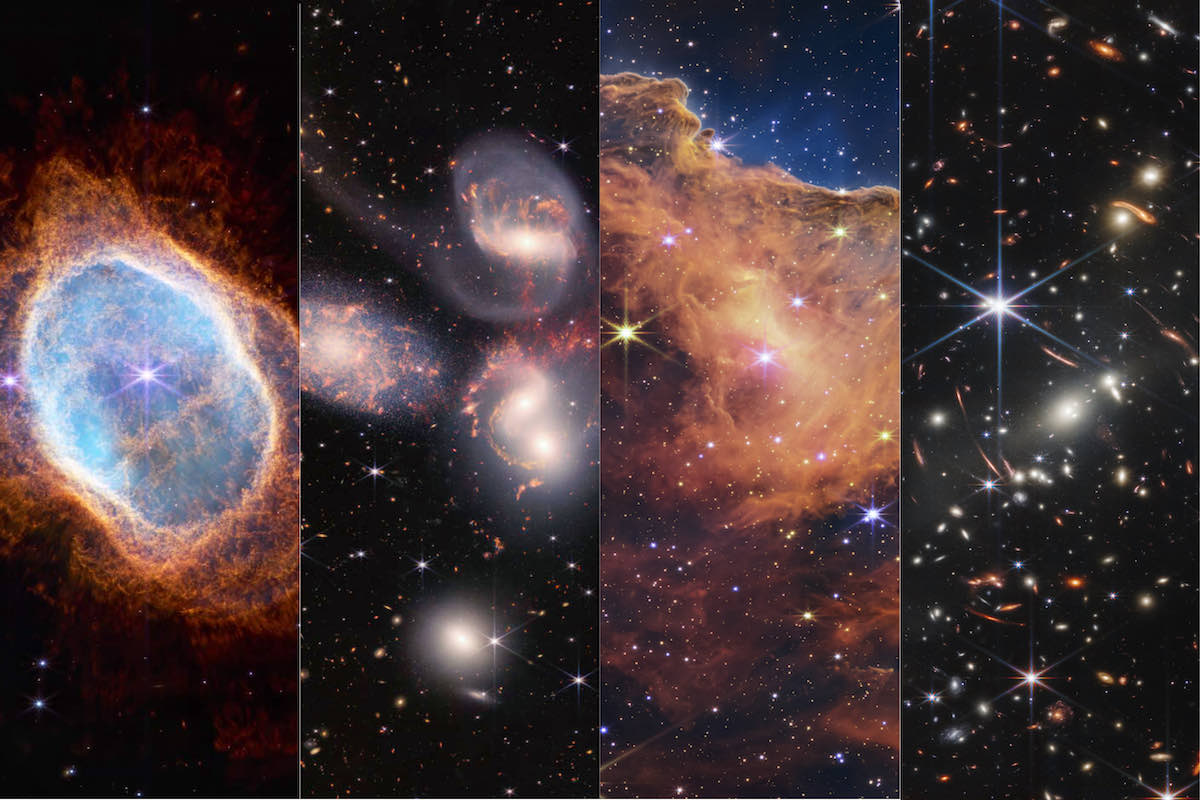 Webb’s view of the Southern Ring Nebula, Stephan’s Quintet, the Carina Nebula, and the galaxy cluster SMACS 0723. Credit: NASA, ESA, CSA, STScI
Webb’s view of the Southern Ring Nebula, Stephan’s Quintet, the Carina Nebula, and the galaxy cluster SMACS 0723. Credit: NASA, ESA, CSA, STScINASA unveiled more spectacular “first light” pictures from the James Webb Space Telescope Tuesday, showcasing interacting galaxies, the death throes of a doomed star and a stellar nursery where massive young suns are being born, blazing with gale-force solar winds that sculpt vast clouds of gas and dust.
https://spaceflightnow.com/2022/07/12/webb-first-light/JWST: NASA says the James Webb Space Telescope is now fully focused and ready for instrument commissioning, a process that will take about 2 months to complete; NASA says the optical performance is better than "the most optimistic predictions”
https://blogs.nasa.gov/webb/2022/04/28/nasas-webb-in-full-focus-ready-for-instrument-commissioning/JWST: It's worth zooming into this image to get a sense of Webb's power:
https://blogs.nasa.gov/webb/wp-content/uploads/sites/326/2022/04/webb_img_sharpness_details_v2.pngWebb telescope sees the prelude to a supernovaMarch 21, 2023 Stephen Clark [SFN]
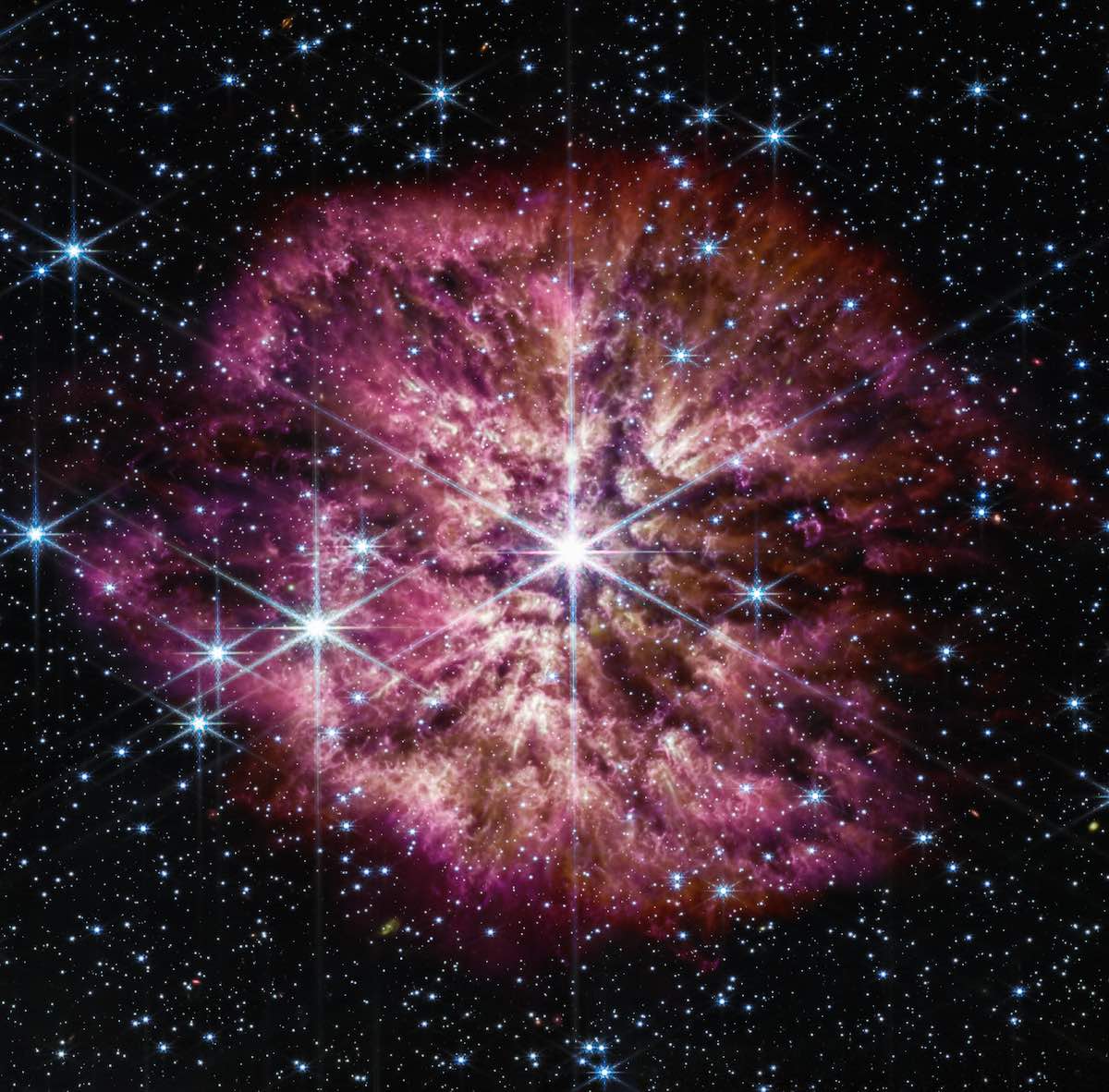 The luminous, hot star Wolf-Rayet 124 (WR 124) is prominent at the center of the James Webb Space Telescope’s composite image combining near-infrared and mid-infrared wavelengths of light from Webb’s Near-Infrared Camera and Mid-Infrared Instrument. Credits: NASA, ESA, CSA, STScI, Webb ERO Production Team
The luminous, hot star Wolf-Rayet 124 (WR 124) is prominent at the center of the James Webb Space Telescope’s composite image combining near-infrared and mid-infrared wavelengths of light from Webb’s Near-Infrared Camera and Mid-Infrared Instrument. Credits: NASA, ESA, CSA, STScI, Webb ERO Production TeamA new image from the James Webb Space Telescope shows a rare glimpse of a massive star 15,000 light-years away shedding a halo of gas and dust, seeding the cosmos with elements necessary for forming other stars, planets, and the building blocks of life.
https://spaceflightnow.com/2023/03/21/webb-telescope-sees-the-prelude-to-a-supernova/JWST Will Hunt for Dead Solar Systems—and Much More—in Its Second Year of ScienceBy Jonathan O'Callaghan on May 18, 2023
White dwarfs, Earth-sized exoplanets, early galaxies and even Saturn’s moon Enceladus are on the agenda for JWST’s second year in space, but exomoons and others miss outWhere do you point the world’s most powerful space telescope? It’s not an easy question. The James Webb Space Telescope (JWST), launched in December 2021, has amazed astronomers since it began sending back its first science data in July 2022. It has seen galaxies breathtakingly close to the dawn of time, probed the atmospheres of exoplanets in unprecedented detail and provided stunning new views of worlds in our solar system. But it’s just getting started. Last week on May 10 astronomers learned if their proposals for the telescope’s second year of science were successful. Competition was fierce, and while there were plenty of winners and some incredible science set to be conducted, there were many more who missed out on JWST’s “Cycle 2,” which starts next month. “There was an extraordinary response from the science community,” says Nancy Levenson, interim director of the Space Telescope Science Institute (STScI) in Maryland, which runs JWST.
https://www.scientificamerican.com/article/jwst-will-hunt-for-dead-solar-systems-and-much-more-in-its-second-year-of-science/